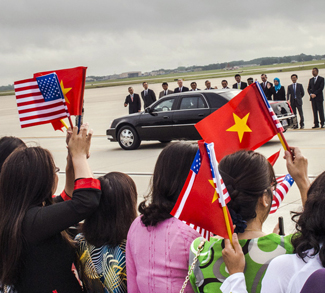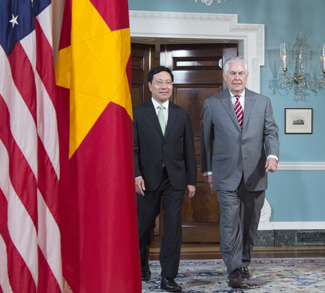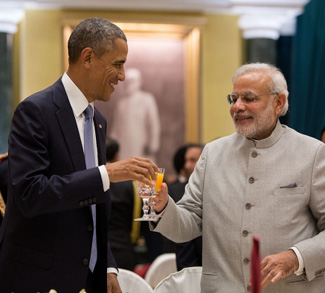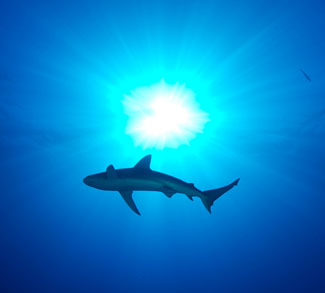While Vietnam, a war-hardened nation, can’t choose its neighbors, it can certainly choose its friends. Once-implacable foes burdened by a bloody and tragic history, Washington and Hanoi increasingly share overlapping strategic interests that will be evident when President Trump hosts Vietnamese Prime Minister Nguyen Xuan Phuc. Their May 31 meeting is significant since Phuc is the first Southeast Asian leader to visit the White House under the new administration, and it offers the possibility of a bilateral trade deal amidst looming security issues surrounding China’s ongoing aggressive behavior in the South China Sea.
Both nations have a common interest in containing China’s island building activities, and the United States regards Vietnam as a key partner in efforts to patrol contested waters. Just last week, the Trump administration agreed to give Vietnam’s coast guard six US-made coastal patrol boats.
Since Washington lifted the arms embargo last year, Vietnam has been in talks with Western and U.S. arms manufacturers about their need to boost their fleet of fighter jets, helicopters, and maritime patrol aircraft. According to many analysts, this regional security cooperation in the South China Sea now includes joint naval exercises. In Vietnam’s efforts to foster a new partnership, US Navy and Coast Guard vessels have been allowed to dock for repairs and maintenance in Cam Ranh Bay, a former American deep-water port during the Vietnam War.
As part of this widening military-to-military engagement, The US Navy has made several port visits in Da Nang, and fostered regular Pacific Partnership visits in Vietnam.
A tighter security alliance with the United States is certainly a goal of Phuc’s administration, said Michael Green, who served on the National Security Council during the George W. Bush administration and was in the White House in 2005, when Vietnam’s prime minister made a historic first-ever visit.
Since 2009, bilateral military cooperation between America and Vietnam has continued to increase security linkages between both nations.
Green, who is now vice president of the Center for Strategic and International Studies, heard from officials in Hanoi that Phuc would like to forge an alliance with Trump similar to the one Trump formed with Japanese Prime Minister Shinzō Abe.
“I know they want to lock in the kind of relationship that Abe did,” said Green. “Vietnam is not a country that wants to distance itself from the United States because Donald Trump is president.”
Hanoi wants the summit to “go well,” Green said.
For the United States, the stakes are high as well. A US Navy ship in recent days set off alarms when it sailed within 12 nautical miles of one of China’s artificial islands as part of the Navy’s broad “freedom of navigation operations.”
Chief of Naval Operations Adm. John Richardson said these are routine operations that the Navy has been conducting since 1979 and are not meant to be “confrontational,” he added. “We do them in the South China Sea. We do them all over the world. They sure get a lot of attention when they happen.”
It is no secret that Vietnam regards China as an existential threat and Phuc would like to see the United States more engaged in the South China Sea, claims CSIS military strategist Anthony Cordesman.
Vietnam and other Southeast Asian countries believe only the United States can curb China’s aggressive actions. One option for the Trump administration is to increase arms sales or transfers of equipment to allies like Vietnam to help shore up their navies.
Vietnam’s defense budget in 2016 was about $4 billion, and it received $12 million in foreign military aid from United States, Cordesman said. There has been speculation for some time that the U.S. will sell or transfer older models of the U.S. Navy P-3 Orion maritime patrol aircraft to Vietnam. Such an acquisition would make sense, said Cordesman, as it would give Vietnam a modern capability to patrol waters and track submarines. “The P-3 is not the cutting edge, but it’s modern enough, and it’s affordable.”
A lot of Vietnam’s military equipment is out-of-date Russian gear. The United States might consider providing some newer ships and weapons to replace aging missile corvettes and frigates. Or it could help modernize older vessels with US-made anti-ship missiles, air-defense systems, and sensors. Under Trump’s proposed budget plans, Vietnam could also find US military donations becoming loans instead.
A military force that is “interoperable” with the United States sends a powerful message, said Cordesman. “It doesn’t have to be a threat to China but it certainly acts as a signal and to some extent a deterrent,” he said. Vietnam is not interested in arming for war, but wants to “be more credible from a negotiating position.”
Former U.S. State Department official Steve Ganyard, now a partner at the consulting firm Avascent, said there is “great anticipation for the prime minister’s visit and hopes of signing a variety of agreements, defense included.”
The US and Vietnam, signed a Comprehensive Partnership in 2013, which covered trade, development, and maritime security, but without calling for specific action. Vietnam has applauded the Trump administration’s strong language when the White House referred to “China’s military fortress” in the South China Sea. However, this rhetoric has quickly faded since the administration has called upon China to pressure North Korea to forego any further nuclear and missile tests.
Washington continues to strengthen its security cooperation with Vietnam, including helping the government build its maritime security capabilities by providing more than $45.7 million since 2014 through the State Department’s Foreign Military Financing and law enforcement capacity-building programs.
All this reinforces that the “US-Vietnam partnership is a critical component of US foreign policy in the Asia Pacific region,” says US Department of State spokeswoman Katrina Adams.
US defense firms realize that Vietnam is still an emerging economy that can’t yet afford “gold-plated” weapons, Ganyard said. But he expects Vietnam to step up its military modernization as the economy improves. “Its capabilities for high-tech innovation are unmatched by any other ASEAN country. And they are more than willing to develop what they can’t buy.”
Since 2009, bilateral military cooperation between America and Vietnam has continued to increase security linkages between both nations. The shared geopolitical interests appears to have been solidified when China first claimed its “nine-dash line” in an attempt to validate its sovereignty claims in the South China Sea. Last year’s international tribunal in The Hague delivered a sweeping rebuke of China’s reclamations of atolls and rocks, and found that its expansive claim to sovereignty over the waters had no legal basis. However, China’s has disregarded the international ruling and continued with the militarization of their reclaimed islands.
“It is an open secret that Vietnam is in the market for coastal radar and maritime patrol aircraft, such as the P-3 Orion. It is a buyer’s market as the U.S., Japan, Australia, and other countries acquire the P-8 Poseidon and retire the Orion. Japan could be a supplier,” claims Carl Thayer from the Australian Defense Force Academy.
The anticipated arrival of Vietnam’s delegation of more than 100 diplomats and business leaders bolsters assurances that Trump will travel to Vietnam in November to attend the APEC Summit. As a sign of expanding business interests between the two countries, the Washington-based US-ASEAN Business Council is hosting a formal dinner reception.
“If the two countries enter a mutually beneficial free-trade agreement that was recently suggested by many American firms doing business in Vietnam, such an agreement will reflect the growing trend and vast potential of our economies and help create more jobs for Americans and Vietnamese alike,” says Dr. Tran Tuan, Minister of Industry and Trade.
While Vietnam was disappointed when the Trump administration signed an executive order withdrawing the U.S. from the Trans Pacific Partnership (TPP), it is eager to know what economic turn the new administration takes on its “America First” campaign.
Prime Minister Phuc seeks to control any impact of the new administration’s efforts to reduce trade by offering to negotiate a bilateral trade agreement with the U.S.
“They also want to get a reading on how the Trump administration plans to engage the region economically after the President canceled the TPP, in which Vietnam would have been a major beneficiary,” claims Murray Hiebert, a senior advisor and Southeast Asia director at CSIS in Washington, D.C.
The opinions, beliefs, and viewpoints expressed by the authors are theirs alone and don’t reflect any official position of Geopoliticalmonitor.com.




